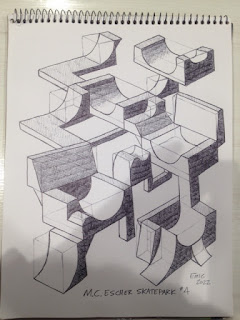My dad, Tom Emig, was a draftsman/engineer, which means that he spent most of his working life sitting in front of a giant tilted table, drawing huge pictures of machine parts. As you can see in this ancient video, before computer use was widespread, every product of any kind was designed and drawn by hand, with pencil, on a drafting board. Those drawings were then used by the people who actually manufactured the products. So I grew up with my dad bringing drawings home now and then, and teaching me what I was looking at, and how to understand them.
As a draftsman's kid, my dad saw me drawing one day, when I was about 8 or 9, and taught me how to do the three standard drafting views of an item, the top, front, and side views. Then he showed me how to draw 3D drawings, called oblique and isometric drawings. An example of an isometric is when you draw a cube where you can see two sides and the top. So along with drawing Army jeeps and tanks, Speed Racer's Mach 5, and the other stuff cool to us 70's kids, I practiced drawing isometric shapes once in a while.
Years later, when I landed a job at BMX Action and FREESTYLIN' magazines, in 1986, I actually didn't have much to do at first. My main job was to proofread both magazines, which kept me busy one week out of the month. For my first couple months, I didn't have much to do for the other three weeks. I spent a lot of time digging into the magazines archives, and reading back issues. When I got tired of that, I started drawing a bit. I went back to my basic drafting techniques my dad, and a couple years of drafting classes in high school, taught me. I started drawing ramp designs. At the time, ramps were either basic quarterpipes or halfpipes. A halfpipe might have a roll-in, but there wasn't much more too them. There were none of the crazy set ups we see at contests or skateparks today.
I started drawing weird combos of ramps, and then sat there looking at the drawings, pretending I was riding those ramps. Then one day, I got a little weird with the drawing. My dad and I were both fans of the work of M.C. Escher. Every trip to a book store, we'd flip through one of the books of his drawings. My dad never bought one, but as a draftsman, engineer, and solver of mechanical puzzles, he loved Escher's intricate and impossible designs.
One day, bored at my desk in my little office in Wizard Publications, I drew my first "M.C. Escher Skatepark." I just pencil sketched a cubist world of ramps, but with the transitions going in different directions. I did maybe 10 or 15 of these, I think, over the course of a couple of months. As my job continued, I found other work to do, and stayed busy all month at the magazines. Those early drawings got lost, probably during one of the times I lost a storage unit, with boxes of my stuff in side.
So a few months ago, after losing yet another storage unit, along with all my artwork and art supplies, I had a small sketchpad and a black pen. I did a little sketching, and drew a few more "M.C. Escher Skateparks." These are two of them in this post.
This one's a bit more chaotic. I sketched these, and 2 or 3 more, in pen, which is why you can see several of the cube lines, where I sketched the cube, then cut away parts to make the ramps.
Here's my dad, Tom Emig, in about 2010, a couple years before his death in 2012. The place I first remember my dad taking me to see his factory was a company called Fate, Root, Heath when he started there, that changed its name to Plymouth Locomotive Works. The designed and built custom locomotives, usually smaller than the freight train locomotives we see on railroads. Plymouths were often small locomotives for switching, special uses, or odd gauge railroads tracks. They also made low slung mining locomotives, like this one, and my dad worked on the design of several of these. My dad worked there, in Plymouth, Ohio, from about 1976 to 1980. Word got around that the company was going to be bought out, and maybe move or shut down, so my dad found a new job in Carlsbad, New Mexico, and we left Ohio in 1980. The Plymouth factory shut down in about 1983. My mom and I visited it 2010, and it is just another decaying rust belt factory complex now, like thousands of others. But Plymouth locomotives were built to last, and now, about 40 years after going out of business, there are still a few Plymouth locomotives in operation.





No comments:
Post a Comment